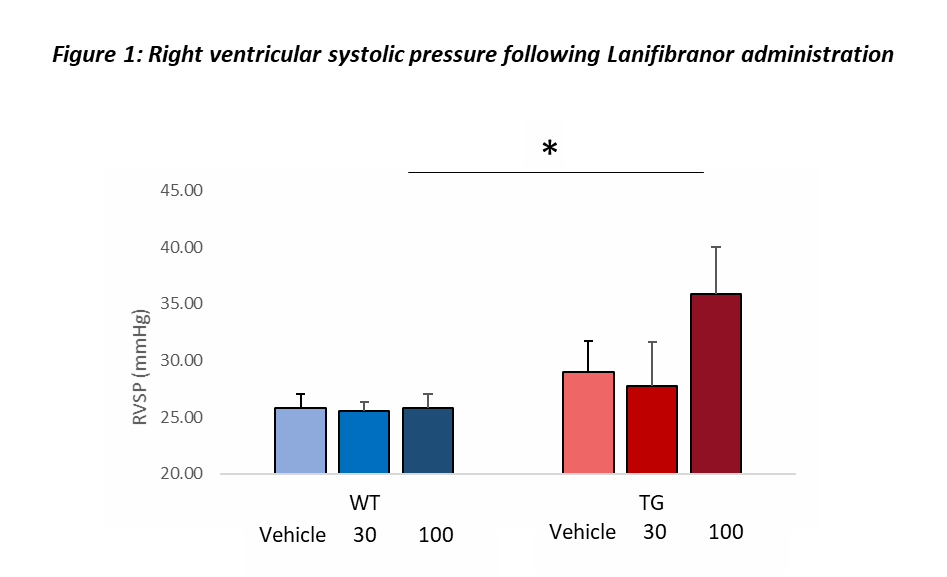Session Information
Date: Monday, November 11, 2019
Title: Systemic Sclerosis & Related Disorders – Basic Science Poster
Session Type: Poster Session (Monday)
Session Time: 9:00AM-11:00AM
Background/Purpose: The TβRIIΔk-fib transgenic mouse model of systemic sclerosis (SSc) develops constitutive structural vasculopathy with vessel wall fibrosis and is susceptible to pulmonary hypertension (PH) induced by the VEGF receptor inhibitor SU5416. This model of SSc-PH results from pulmonary endothelial cell (EC) injury leading to endoluminal EC proliferation. The pan-peroxisome proliferator-activated receptor (PPAR) agonist Lanifibranor has recently been tested in a phase II clinical trial in SSc, and PPAR nuclear receptors are reported to have beneficial effects on haemodynamics in human PH. We have explored the effect of lanifibranor on TβRIIΔk-fib mice receiving SU5416 to trigger PH.
Methods: 8-12 week old TβRIIΔk-fib mice (n=33) and littermate sex-matched WT mice (n=29) were administered one of two doses of lanifibranor (30 mg/kg- low dose- or 100 mg/kg- high dose) or vehicle administered by daily oral gavage for 23 days. On day 2 a single 50mg/kg dose of SU5416 in carboxymethylcellulose vehicle was administered by intraperitoneal injection. Right (RVSP) and left ventricular (MABP) pressures and Fulton index were measured on terminally anaesthetised mice according to local protocols. Histological and immunohistochemical assessment of pulmonary and cardiac tissue was performed.
Results: As expected, no significant differences in MABP were seen across groups. All mice had some elevation of RVSP compared to published baseline pressures in this model due to administration of SU5416 in all groups. TG mice treated with vehicle developed elevated RVSP compared to WT mice in the vehicle groups consistent with previous studies [1]. TG mice treated with high dose lanifibranor demonstrated generally higher RVSP than those treated with vehicle or low dose lanifibranor, for instance: mean RVSP TG-SU-100 35.89 ±4.1; TG-SU vehicle 29.0±2.7; p< 0.05) with some values exceptionally high (54 mmHg; 49 mmHg; figure 1). Increased endothelial cell proliferation within pulmonary vessels for mice receiving lanifibranor was identified as the likely cause using Ki-67 immunohistochemistry staining. Despite the elevation in RVSP in those mice treated with lanifibranor at high dose, there was no significant increase in RV mass when compared to other groups (for instance, RV/LV+S in TG-SU-100 0.24±0.007; WT-SU-100 0.24±0.005; not significant; figure 2).
Conclusion: Treatment with high dose lanifibranor exacerbated SU5416-induced pulmonary hypertension in the TβRIIΔk-fib mouse model of SSc without resultant increases in RV mass according to Fulton index. Mechanistically, we propose that agonism of different PPAR isoforms in the pulmonary circulation results in exaggerated EC proliferation after SU5416 leading to paradoxical worsening of PH, but protection from the right ventricular hypertrophy that occurred in control mice. Thus, the right ventricular outcomes in our study suggest that there might be protection against RV dilatation and hypertrophy in other forms of murine PH and in human PAH that may positively impact on clinical outcome.
Reference:
1. Derrett-Smith et al, Arthritis Rheum. 2013; 65:2928-39.
To cite this abstract in AMA style:
Derrett-Smith E, Clark K, Xu S, Abraham D, Lacombe O, Broqua P, Junien J, Konstantinova I, Denton C. The PPAR Agonist Lanifibranor Protects Against Right Ventricular Hypertrophy in a Mouse Model of Systemic Sclerosis Associated Pulmonary Hypertension [abstract]. Arthritis Rheumatol. 2019; 71 (suppl 10). https://acrabstracts.org/abstract/the-ppar-agonist-lanifibranor-protects-against-right-ventricular-hypertrophy-in-a-mouse-model-of-systemic-sclerosis-associated-pulmonary-hypertension/. Accessed .« Back to 2019 ACR/ARP Annual Meeting
ACR Meeting Abstracts - https://acrabstracts.org/abstract/the-ppar-agonist-lanifibranor-protects-against-right-ventricular-hypertrophy-in-a-mouse-model-of-systemic-sclerosis-associated-pulmonary-hypertension/


